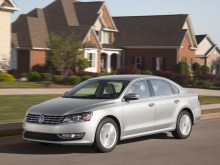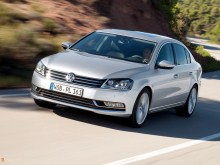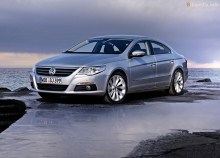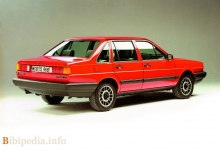Characteristics Volkswagen Passat.
Characteristics of Passat US since 2011
| Modification | Power, kW (hp) / about | Fuel consumption (medium), l / 100 km | Weight (mass), kg |
|---|---|---|---|
| 2.5L 5-MCPP (170 hp) | 127(170)/5700 | 9 | 1436 |
| 2.5L 6-automatic transmission (170 hp) | 127(170)/5700 | 9.1 | 1461 |
| 3.6L V6 (280 HP) | 206(280)/6200 | 10.1 | 1563 |
| 2.0 TDI 6-automatic transmission (140 hp) | 103(140)/4000 | 6.9 | 1569 |
| 2.0 TDI 6-MCPP (140 hp) | 103(140)/4000 | 6.5 | 1539 |
Characteristics of Passat B7 since 2010
| Modification | Power, kW (hp) / about | Fuel consumption (medium), l / 100 km | Weight (mass), kg |
|---|---|---|---|
| 1.4 TSI DSG. | (122)/5000 | 6.4 | 1463 |
| 1.4 TSI MT. | (122)/5000 | 6.3 | 1440 |
| 1.8 TSI DSG. | (152)/5000 | 7.1 | 1514 |
| 1.8 TSI MT. | (152)/5000 | 7 | 1499 |
| 2.0 TDI DSG. | (170)/4200 | 5.3 | 1591 |
| 2.0 TSI DSG. | (210)/5300-6200 | 7.7 | 1544 |
Characteristics of Passat CC since 2009
| Modification | Power, kW (hp) / about | Fuel consumption (medium), l / 100 km | Weight (mass), kg |
|---|---|---|---|
| 2.0 TDI | 102.9(139.9)4200 | 7.6 | 1430 |
| 1.8 Tsi. | 117.8(160.2)5000 | 7.6 | 1430 |
| 3.6 FSI | 220.7(300.1)6600 | 10.1 | 1430 |
| 1.8 TSI DSG. | (152)/5000-6200 | 7.3 | 1513 |
| 1.8 TSI MT. | (152)/5000-6200 | 7.6 | 1505 |
| 2.0 TSI DSG. | (200)/5100-6000 | 8.5 | 1533 |
| 3.6 4motion DSG. | (300)/6600 | 10.1 | 1702 |
Features Passat B6 2005 - 2010
| Modification | Power, kW (hp) / about | Fuel consumption (medium), l / 100 km | Weight (mass), kg |
|---|---|---|---|
| 1.9 TDI | 77(105)/4000 | 5.6 | 1397 |
| 2.0 TDI (140 hp) | 103(140)/4000 | 5.8 | 1429 |
| 2.0 TDI (170 hp) | 125(170)/4200 | 6.1 | 1432 |
| 1.6 | 75(102)/5600 | 7.7 | 1318 |
| 1.6 FSI | 85(115)/6000 | 7.5 | 1323 |
| 2.0 FSI | 110(150)/6000 | 8.2 | 1364 |
| 2.0 turbo FSI | 147(200)/5100 | 8.1 | 1420 |
| 3,2 V6 FSI 4Motion | 184(250)/6200 | 9.8 | 1635 |
Features Passat B5 2000 - 2005
| Modification | Power, kW (hp) / about | Fuel consumption (medium), l / 100 km | Weight (mass), kg |
|---|---|---|---|
| 1.9 TDI (100 LS) | 74(100)/4000 | 5.4 | 1326 |
| 1.9 TDI (130 hp) | 96(130)/4000 | 5.6 | 1342 |
| 2.5 TDI (150 hp) | 110(150)/4000 | 6.9 | 1463 |
| 2.5 TDI (163 hp) | 120(163)/4000 | 6.8 | 1534 |
| 2.5 TDI (180 hp) | 132(180)/4000 | 7.6 | 1642 |
| 1.8 Turbo. | 110(150)/5700 | 8.2 | 1320 |
| 2.0 (115 hp) | 85(115)/5400 | 8.4 | 1285 |
| 2.0 (130 hp) | 96(130)/5700 | 8 | 1291 |
| 4.0 W8. | 202(275)/6000 | 13.1 | 1664 |
| 1.6 | 75(102)/5600 | 7.7 | 1252 |
| 2.3 V5. | 125(170)/6200 | 9.4 | 1393 |
| 2.8 V6. | 142(193)/6000 | 10.7 | 1499 |
Features Passat B5 1996 - 2000
| Modification | Power, kW (hp) / about | Fuel consumption (medium), l / 100 km | Weight (mass), kg |
|---|---|---|---|
| 1.9 TDI (110 hp) | 81(110)/4150 | 5.3 | 1289 |
| 1.9 TDI (115 hp) | 85(115)/4150 | 5.3 | 1319 |
| 1.9 TDI (90 LS) | 66(90)/4000 | 5.3 | 1280 |
| 2.5 TDI | 110(150)/4000 | 6.8 | 1423 |
| 1.8 | 92(125)/5800 | 8.5 | 1236 |
| 1.8 Turbo. | 110(150)/5700 | 8.1 | 1286 |
| 1.6 | 74(100)/5300 | 8 | 1206 |
| 2.3 VR5 | 110(150)/6000 | 10.1 | 1310 |
| 2.8 V6. | 142(193)/6000 | 10.5 | 1413 |
Characteristics of Passat B4 1993 - 1996
| Modification | Power, kW (hp) / about | Fuel consumption (medium), l / 100 km | Weight (mass), kg |
|---|---|---|---|
| 1.9 TD. | 55(75)/4200 | 6.5 | 1232 |
| 1.9 TDI (110 hp) | 81(110)/4150 | 5.1 | 1240 |
| 1.9 TDI (90 LS) | 66(90)/4000 | 5.3 | 1246 |
| 1.8 (75 hp) | 55(75)/5000 | 8.2 | 1177 |
| 1.8 (90 LS) | 66(90)/5500 | 7.9 | 1199 |
| 2.0 (116 hp) | 85(116)/5400 | 8.1 | 1199 |
| 2.0 (150 hp) | 110(150)/6000 | 8.5 | 1259 |
| 2.8 VR6. | 128(174)/5800 | 9.6 | 1325 |
Characteristics of Passat B3 1988 - 1993
| Modification | Power, kW (hp) / about | Fuel consumption (medium), l / 100 km | Weight (mass), kg |
|---|---|---|---|
| 1.6 TD. | 59(80)/4500 | 6 | 1192 |
| 1.9 D (68 hp) | 50(68)/4400 | 6.3 | 1184 |
| 1.9 D (75 hp) | 55(75)/4200 | 6.3 | 1217 |
| 1.6 | 53(72)/5200 | 7.7 | 1106 |
| 1.8 (107 hp) | 79(107)/5700 | 7.8 | 1185 |
| 1.8 (75 hp) | 55(75)/5000 | 8 | 1113 |
| 1.8 (90 LS) | 66(90)/5400 | 7.9 | 1148 |
| 1.8 G60 | 118(160)/5600 | 9.9 | 1356 |
| 2.0 (116 hp) | 85(116)/5400 | 8.2 | 1169 |
| 2.0 (136 hp) | 100(136)/5800 | 8.9 | 1229 |
| 2.8 VR6. | 128(174)/5800 | 9.6 | 1280 |
Characteristics of Passat B2 1981 - 1988
| Modification | Power, kW (hp) / about | Fuel consumption (medium), l / 100 km | Weight (mass), kg |
|---|---|---|---|
| 1.6 D. | 40(54)/4800 | 6.4 | 964 |
| 1.6 TD. | 51(69)/4500 | 6.2 | 1007 |
| 1.3 | 44(60)/5600 | 7.5 | 940 |
| 1.6 (72 hp) | 53(72)/5200 | 8.5 | 967 |
| 1.6 (75 hp) | 55(75)/5000 | 8.4 | 957 |
| 1.8 | 66(90)/5200 | 7.5 | 946 |
| 1.8i | 66(90)/5200 | 8.5 | 946 |
| 2 | 85(115)/5400 | 8.3 | 1043 |
| 2.2 | 83(113)/5400 | 8.6 | 1074 |
Opinion about Volkswagen Passat B6
A little story
Volkswagen Passat (Volkswagen Passat) is a high-size sedan from Volkswagen, standing on the step above Jetta in the classification and offering the best characteristics and more complex design. The first generation of the model appeared in 1974 and marked the beginning of a new era for the company with its front-wheel drive and liquid engine cooling. In 1997, there was another generation of Passat with a brighter appearance and slightly increased size compared to the predecessor. The last generation was published in 2005, having received an extended wheeled base, an extended rut and many updates both outside and inside.

Volkswagen Passat B6 is not much different from its predecessors. The manufacturer still sees the middle class by its potential client. The new version of the trade wind has increased slightly in size: 6 cm long and 8 cm wide, so it looks more representative than the versions of the older generations. By contour, he is close to Volkswagen Phaeton.
By the design of the cabin, it is also similar to Phaeton. The style is classic, representative, there is no gram of eccentricity. Thanks to the quality of execution, it can be called even gorgeous. Office employees will definitely have to taste its restraint.
If you stop at the cabin, I do not advise you to inflate about its capacity. Large comrades will not feel comfortable in it. It's all about the form of the bottom: its ends are issued inside. For this reason, a person sitting on the front passenger chair will be forced to direct legs to the left. Not very convenient will be a tall person.
There is no standard manual brake. In its place there is a department for trifles. Turn on the handbrake you can with the button located near the light switch. I consider it a good innovation, very modern. Especially like the car when switching on the transmission itself removes the brake.
On the technical characteristics of Passat B6
Volkswagen remains faithful: execution at the highest level. Excellent steering, keeps the road, swallows the pits. Lovers to drive approve. At first glance, noise insulation is not at the height. It is treated with the replacement of regular tires - too tough. With new rubber with Shumkov, there are no problems up to 170 km / h, when when conversation already has to strain the bundles.
Body, chassis
In our country, the sedan is more common than the wagon. The first is somewhat cheaper. LCP B6 loses compared with the quality of the fifth generation versions. A few years after buying on the car, there will be scratches. In this regard, B6 reminds Japanese cars. Then the chrome elements will fade. But the reason for this is not saving the manufacturer, and domestic caustic road reagents.
The main disadvantage of the fifth generation was the unsuitful chassis. I needed overhax for 40,000 km! The worst chassis from all classmates. At B6 progress is insignificant. I, as a fan of Volkswagen, was quite a little disappointed. The silent of the rear levers broke out at 17,000 km, ball. Well, if your warranty period has not expired. But who knows how much new details will serve? Many at this time change steering racks, brake discs.
As always, the concern provides a rich selection of engines. 1.6-liter gasoline motor with 102 hp (MPI) the most modest and durable. Non-additive to fuel, you can refill 92 and 95. The capricious engines are more common with 1.6-3.2 liters (FSI). The manufacturer notifies consumers in advance that these motors consume only 98 gasoline. Their diseases include breakdowns of ignition coils, failure of the engine control unit (2 l). 1,8-liter engine (TSI) is longer, although high pressure pump valves are broken.
Among the diesel engines, we have the most common 1.9-liter and 2-liter TDI motor. Due to the use of domestic base diesel fuel, the life of the fuel pump and injection nozzles is reduced.
Most engines eat oil. Therefore, I always advise with yourself to have a canister just in case at least two-liter. Fans of aggressive ride motor can eat 1l / 1000 km on a new car !!! Concern, attention! considers it the standard!
Now I will stop at the checkpoint. Volkswagen provides 3 options: MCPP, automatic transmission and DSG. Each box has its own nuances. Probably the most durable nevertheless mechanical, however, it happens that the clutch joined it. The valve block breaks on automatic. And DSG does not live at all to 60,000 km. As a rule, this is explained by the lack of experience in the operation of this checkpoint, but personally I adhere to a somewhat different point of view.
Weak spots
Often in the cooler it gets dirty. As a result, the motor burns out, and the owner does not do anything but make kapitalku. Crack fog lights. Brings electronics. Often fly earbegov controllers, heating seats. Do not be surprised if it becomes parktronic kink or block of seats with electrical. There are cases warranty replacement priborok suddenly breaking down.
Price
In view of the frequent occurrence of problems I find prices for Volkswagen Passat B6 overstated.
Output
I can not call this model reliable. Its operation is not cheap, it was typical for B5. Buying this model, be prepared for frequent visits to the service.
Among other things, before the purchase is recommended to check the level of light transmission glasses, if the windows are covered with even a light film. The fact is that for a long enough time in Russian car windows tinted armored and low-quality film is not appropriate GOST. For more information on toning GOST can be found at: www.gosttonirovka.ru.
Opinion of the Volkswagen Passat B5
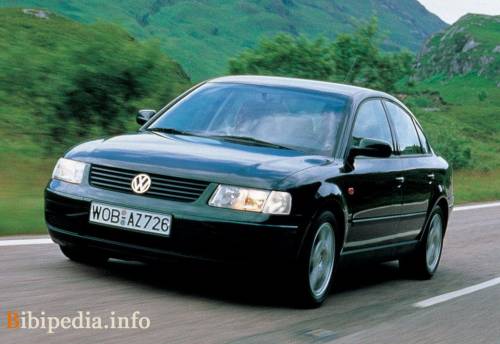
Volkswagen Passat B5, was released in '96 Consumers fell in love with excellent steering, comfort and, of course, modern exterior and interior. Sales were so successful that the manufacturer thought about Restayl only in 2000
The minimum equipment implied presence airbegov 4, the antilock brake system, a mirror heater, air conditioner, tinting, the driver's seat with adjustable height. To enhance security, there were protivozanosnaya and traction control. In this list from 2002 it was included climate. In a modification Komfortlayn, Trendlayn and rear electric Highline added. These versions differ in design interior. Komfortlayn: velor upholstery or dark beige. Trendlayn: the inclusion of aluminum. Highline: black and cream colors. You can order a casting shop on the skin, Bi-Xenon headlights. In addition to front-wheel drive and was variant with four-wheel drive, but the price was higher.
At the present time in the secondary market rather wide range of Tradewinds B5. Although many believe that the used OP 5 are a lot of disadvantages.
Body and chassis
In our country, the most common cheaper sedan, wagon less. Galvanized body, so do not be surprised guarantee for 12 years. Corrosion can be found only on the car, got in an accident.
The machine is not afraid of our climate. Although it happens that the paint shed on the front arches - the perpetrator to the gravel.
The chassis from the Passat of the fifth generation is terrible, loses to all classmates. The bulkhead is already required by 35,000 km. This running has become the first "multi-dimension" concern Volkswagen. It is not designed for our roads. The weakest place is levers. Designers tried to improve them, but did not solve the problem. In essence, these consumables of the Passat of B5, as well, and ball, and steering tips, and stabilizers.
The simplest of the benzo engines is the 1.6-liter engine with 4 cylinders, it is the most durable. Eats 92. A new 150-strong turbogo volume of 1.8 liters and an intrinsic 125-strong same volume enjoyed in high demand. They are committed to gasoline and need timely that. Pindy fuel reduces the life of the throttle motor. The turbine serves to 170,000 km. In order to avoid replacing the previous time after stopping, it is advised to wait before the plug.
V6 disease is a lambda probe breakdown (5000 rubles) and a constant leakage of the valve cover. The 2.3-liter motor with 5 cylinders is rather durable, its only minus is noise.
I draw attention to the fact that gasoline engines eat oil, so it is necessary to have at least a two-liter canister to replenish the necessary reserves: 1000 km \u003d 1l. If you ignore this problem, you will have to make a motor overhaul. At the failure of the turbine for the repair will have to pay from 12,000 rubles. either buy a new one (minimum 25,000 rubles)
Now more about transmissions. The most durable - manual transmission, even if the replacement is necessary, it will cost inexpensively. The automatic transmission on versions with a motor with 4 cylinders with timely that also does not cause hassle, the replacement is inexpensive. The most unreliable is the Tittronic: it starts to bite after 110,000 km. Such salts used by domestic communal services and adversely affect electrical discs. Consumption for the bulkhead of this box can reach 120 thousand rubles.
Other malfunctions
Often the radiator is clogged. As a result, the motor heats up too much and fails.
Price
In my opinion, taking into account the capriciousness of the car, the cost of the Passat B5 in the secondary market is unreasonably overestimated. Although the price of a new car is high enough, especially in comparison with other brands, the used car does not cost 300,000 rubles.
Output
The Volkswagen Passat of the fifth generation has many drawbacks and at the same time requires major costs during operation. In addition, this model is often hijacked. In my opinion, it is better to purchase a new car below the class or a used Japanese car.
25.09.2012

